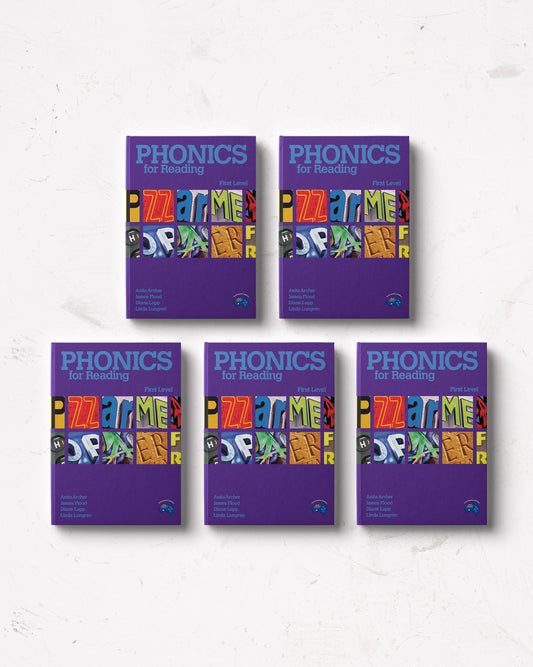The Science of Reading: A Quick Overview
The Science of Reading provides a research-backed blueprint for teaching reading, emphasising the importance of foundational skills such as phonemic awareness, phonics and decoding, alongside fluency, vocabulary and comprehension. It advocates for explicit, systematic instruction tailored to individual learner needs, underpinned by continuous assessment.
Key Instructional Approaches
Structured Literacy
PHONICS for Reading is a comprehensive program that builds strong foundations for early literacy. It systematically teaches essential skills including phonics, phonemic awareness, oral language, vocabulary, comprehension, and fluency. As students master these building blocks, they develop the ability to read confidently for both learning and enjoyment, setting them up for long-term reading success.
Knowledge-Rich Curriculum
CARS & STARS is a strategic literacy program that enhances students' critical thinking and reading comprehension. It identifies crucial knowledge, organises it into a coherent sequence, and systematically develops students' understanding across various genres and subject areas. This structured approach ensures that learners progressively build the essential skills needed for effective literacy and analytical thinking.
Explicit Teaching Framework
Our programs utilise a responsive, evidence-based instructional methodology that emphasises effective learning strategies. This approach incorporates modelling, worked examples, regular comprehension checks, and both guided and independent practice sessions. By carefully structuring lessons and consistently monitoring student progress, we ensure that learners receive tailored support and achieve optimal educational outcomes.
PHONICS for Reading: Laying the Foundation for NAPLAN Success
PHONICS for Reading is a structured program designed to develop phonemic awareness, phonics skills and decoding abilities. It aligns perfectly with the Science of Reading's emphasis on systematic phonics instruction as essential for early reading development. Here's how it fits into the framework:
- Systematic and Explicit Instruction: Starting with simple phonemic awareness activities and advancing through complex phonics skills, PHONICS for Reading offers a step-by-step approach that mirrors the Science of Reading's recommendations for literacy instruction.
- Multi-Sensory Engagement: By incorporating visual, auditory and kinaesthetic learning activities, PHONICS for Reading caters to diverse learner profiles, reinforcing memory and skill acquisition in line with cognitive science findings.
- From Decoding to Reading: The program not only teaches phonics but also encourages its application in reading contexts, promoting fluency and preparing students for higher-level reading tasks, directly supporting the reading and language conventions components of NAPLAN.
CARS & STARS: Advancing to Comprehension and Elevating NAPLAN Performance
While PHONICS for Reading addresses foundational reading skills, CARS & STARS focuses on comprehension, teaching students the strategies to understand, analyse and interpret texts. Its role in the Science of Reading framework includes:
- Strategic Reading Instruction: CARS & STARS equips students with specific strategies such as making inferences, summarising and identifying main ideas – skills that are crucial for comprehension and supported by the Science of Reading.
- Data-Driven Differentiation: The program's assessment tools align with the Science of Reading's emphasis on using data to inform instruction, allowing teachers to identify student needs and tailor their teaching approaches accordingly.
- NAPLAN-Aligned Comprehension Strategies: The comprehension strategies taught in CARS & STARS align with the skills assessed in NAPLAN reading tests, giving students practical tools to tackle NAPLAN questions.
Integrating Both Programs: Maximising NAPLAN Results through the Science of Reading
For Australian educators looking to enhance their literacy instruction, integrating PHONICS for Reading and CARS & STARS within the Science of Reading framework offers a comprehensive approach:
Begin with PHONICS for Reading
Focus on developing strong foundational skills in phonemic awareness and phonics. This ensures all students have the decoding skills necessary for fluent reading.
Transition to CARS & STARS
Once students demonstrate proficiency in decoding, introduce comprehension strategies through CARS & STARS. This sequential approach from decoding to comprehension is advocated by the Science of Reading.
Use Assessment for Tailored Instruction
Employ the assessment components of both programs to continuously monitor student progress, identify areas for improvement and differentiate instruction accordingly. This data-driven approach allows teachers to target specific NAPLAN skill gaps.
Incorporate Writing and Oral Language
Supplement these programs with writing and oral language activities to reinforce phonics skills, enhance vocabulary and improve comprehension.
NAPLAN Success Through Evidence-Based Practice
For Australian teachers, integrating PHONICS for Reading and CARS & STARS with Science of Reading principles provides a balanced, evidence-based approach to reading instruction that directly addresses the skills measured in NAPLAN assessments. This integration ensures students not only learn to decode efficiently but also develop the critical comprehension skills necessary for NAPLAN success, academic achievement and lifelong learning. By adopting this comprehensive approach, educators can better meet the diverse needs of their students, close persistent achievement gaps and pave the way for a future of confident, proficient readers who excel in standardised assessments and beyond.
Ready to Transform Your Students' Literacy Outcomes?
Experience the power of research-backed literacy instruction with no commitment.
START A 30-DAY FREE TRIAL NOW WITH CARS & STARS ONLINENo credit card required. Full access to all features.







